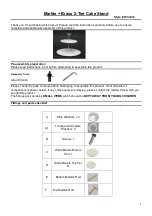
Table
Page 4-15
Statistics
This menu is not a management option; it is a title for the sub-menus
listed below it. This menu CANNOT be selected.
Table
This menu allows you to view real-time statistical information, in a table
format, on the device, a selected group, or a selected port.
Table 4-15 describes each field in the Table menu.
∆
Note:
For instructions on using this menu, see “View-
ing Statistics” on page 3-24.
Table 4-15 Table Menu
Field
Description
Sampling Interval
Configurable field; allows you to set the amount of time (in
seconds) that the device/group/port is polled for information.
Reset
Button; resets the counters to zero in the statistics table.
Object
Read-only fields; displays the objects for which statistics are
gathered.
❏
Good Frames — the total number of good or read-
able frames (frames without error).
❏
Multicast Frames — the total number of frames that
are simultaneously received and are directed to an
active non-broadcast group address. This does not
include frames received with a frame-too-long, runt,
FCS, or alignment error.
❏
Broadcast Frames —
the total number of frames that
are successfully received and are directed to the
broadcast group address.
❏
Collisions — the total number of collisions.
❏
Frames TooLong Errors — the number of frames that
were longer than 1,518 bytes.
❏
Runts — the number of frames that were shorter
than 64 bytes.
❏
Alignment Errors —the number of frames that were
an integral number of octets in length and did not
pass the FCS check.
❏
Fragments —
the number of frames received that are
less than the minimum permitted frame size and
have a bad FCS or alignment error.
❏
FCS Errors — the number of frames that failed Cyclic
Redundancy Check (CRC).
❏
Late Collisions — the number of collisions that
occurred after the 64-byte collision window.
Bay PM book Page 15 Wednesday, August 27, 1997 1:23 PM












































